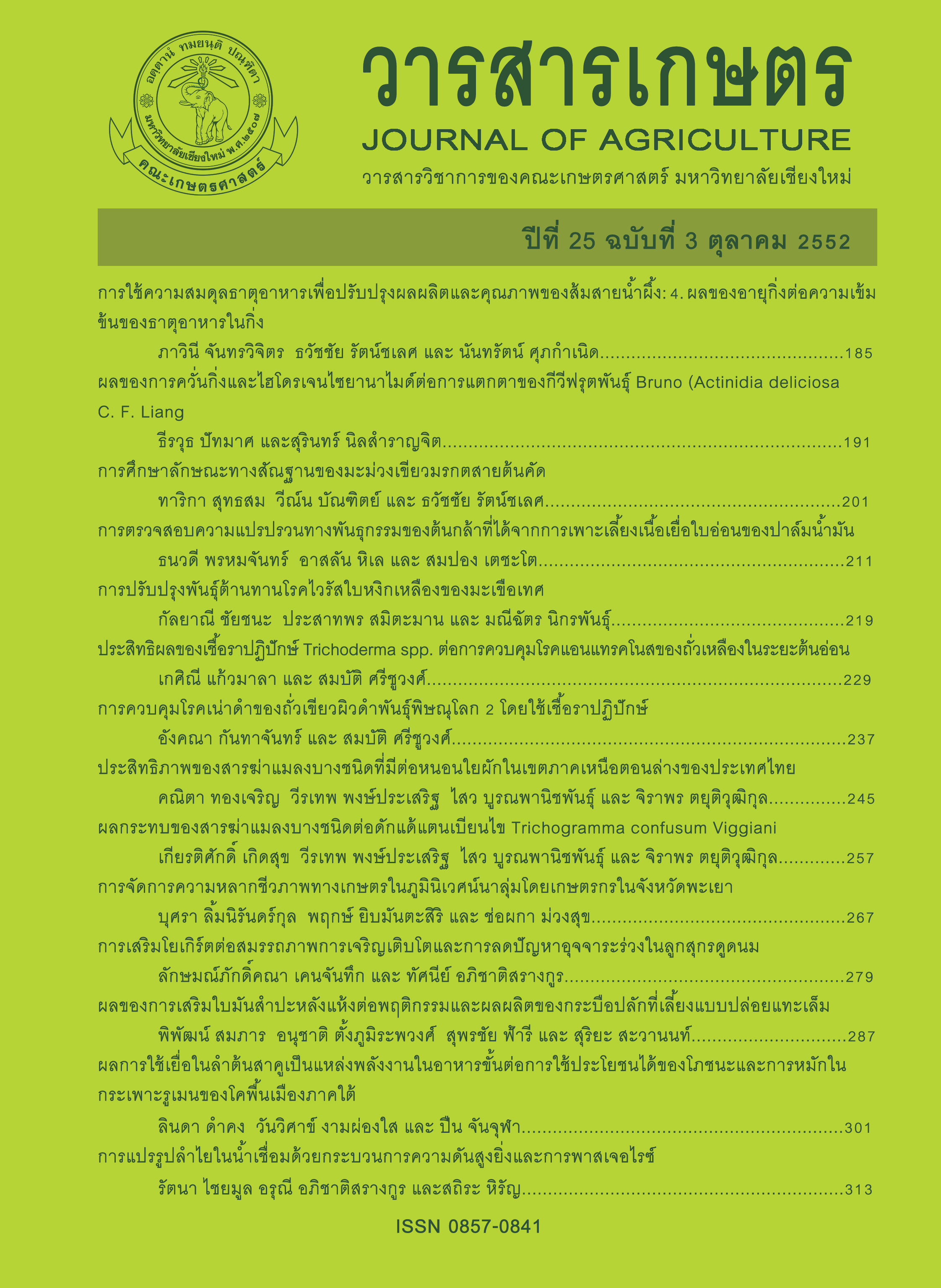Varietal Improvement of Tomato for Tomato Yellow Leaf Curl Virus Resistance
Main Article Content
Abstract
Improvement of tomato for resistance to tomato yellow leaf curl virus (TYLCV) was carried out by using a pedigree and backcrossing methods and crossing between resistant parent H-24 with susceptible parents CT-1 and CT-2. The virus was transmitted by viruliferous whiteflies and virus infection was detected by sandwich ELISA. In F2 generation showed moderately level of resistance with scores ranging from 1.58 - 3.21. Segregation of disease resistance was observed among the population. The F2 populations (scoring 1 or 2) showed absorbance ranging from 0.247 - 0.2565 which were not statistically different from H24 and showed lower virus titer. However, they were significantly different from CT-1,CT-2 and susceptible control. The absorbance of inbred were 0.3851 1.3825 and 1.5820, respectively. The disease severity and virus titer in infected plants of F2 populations showed positive correlation. From this breeding experiment, 6 lines selected from F2CT-1xH-24 and 5 lines selected from F2 CT-2xH-24 showing TYLCV resistance with the score of 1 were obtained.
Article Details
References
อรประไพ คชนันท์ นุชนาถ วารินทร์ ชาญณรงค์ ศรีภิบาล รัชนี. ฮงประยูร และสุพัฒน์ อรรถธรรม. 2544. การผลิตโมโนโคนอลแอนติบอดีต่อโปรตีนห่อหุ้มอนุภาคไวรัสใบหงิกเหลืองมะเขือเทศและไวรัสในกลุ่ม. หน่วยปฏิบัติการพันธุวิศวกรรมด้านพืช ศูนย์พันธุวิศวกรรมและเทคโนโลยีชีวภาพแห่งชาติ และภาควิชาโรคพืช คณะเกษตร ศาสตร์ มหาวิทยาลัยเกษตรศาสตร์, กรุงเทพฯ. 13 หน้า.
อรวรรณ ชัชวาลการพาณิชย์. 2544. เจมิไนไวรัสที่เข้าทำลายพืช. หน่วยปฏิบัติการพันธุวิศวกรรมด้านพืช ศูนย์พันธุวิศวกรรมและเทคโนโลยีชีวภาพแห่งชาติ และภาควิชาโรคพืช คณะเกษตร ศาสตร์ มหาวิทยาลัย เกษตรศาสตร์, กรุงเทพฯ. 6 หน้า.
Czosnek, H. and H. Laterrot. 1997. A world wild survey of tomato yellow leaf curl viruses. Arch. Virol 142: 1391-1406.
Hanson, P. M., D. Bernacchi, S. K. Green, S. D. Tanksley, V. Muniyappa, A. S. Padmaja, H. M. Chen, G. Kuo, D. Fang and J. T. Chen. 2000. Mapping a wild tomato introgression associated with tomato yellow leaf curl virus resistance in a cultivated tomato line. J. Amer. Soc. Hort. Sci. 125(1): 15-20.
Kalloo, G. and M. K. Banerjee. 1990. Transfer of tomato leaf curl virus resistance from Lycopersicon hirsutum f. glabratum to L. esculentum. Plant Breeding 105: 156-159.
Kasrawi, M.A., M.A. Suwwan and A. Mansour. 1988. Sources of resistance to tomato yellow leaf curl virus (TYLCV) in Lycopersicon species. Euphytica 37: 61-64.
Lapidot, M., M. Friedmann, O. Lachman, A. Yehezkel, S. Nahon, S. Cohen and M. Pilowsky. 1997. Comparison of resistance level to tomato yellow leaf curl virus among commercial cultivars and breeding lines. Plant diseases 81: 1425-1428.
Lapidot, M., M. Friedmann, M. Pilowsky, R. Ben-Joseph and S. Cohen. 2001. Effect of host plant resistance to tomato yellow leaf curl virus (TYLCV) on virus acquisition and transmission by its whitefly vector. Phytopathology 91: 1209-1213.
Lapidot, M. and M. Friedmann. 2000. Breeding for resistance to whitefly-transmitted geminiviruses. Annuals of Applied Biology 140(2): 109-127.
Moriones, E. 2000. TYLCV datasheet. EWSN, Norwich.
Nakhla, M. K., D. P. Maxwell, R. T. Martinez, M. G. Carvaeho and R. L. Gilbertson. 1994. Widespread occurrence of the eastern Mediterranean strain of tomato yellow leaf curl geminivirus in tomatoes in the Dominican Republic. Plant Disease 78: 926.
Picó, B. M, J. Díez and F. Nuez. 1998. Evaluation of whitefly-mediated inoculation techniques to screen Lycopersicon esculentum and wild relatives for resistance to tomato yellow leaf curl virus. Euphytica 101: 259-271.
Rubio, L., J.R. Herrero, J. Sarrió, P. Moreno and J. Guerri. 2003. A new approach to evaluate relative resistance and tolerance of tomato cultivars to begomoviruses causing the tomato yellow leaf curl disease in Spain. Plant Pathology 52: 763-769.
Vidavsky, F. and H. Czosnek. 1998. Tomato breeding lines immune and tolerant to tomato yellow leaf curl virus (TYLCV) issued from Lycopersicon hirsutum. Phytopathology 88: 910-914.


